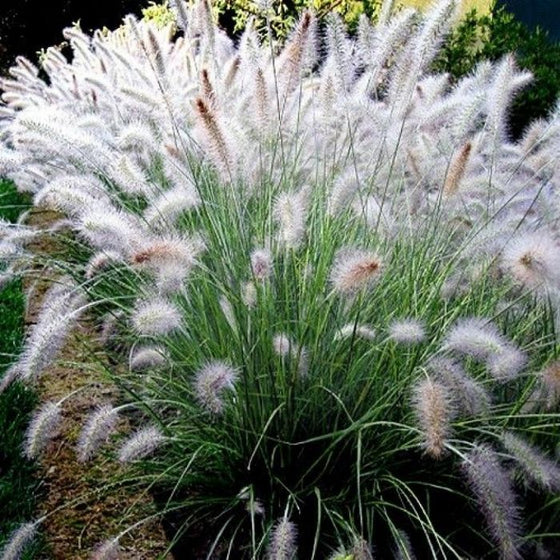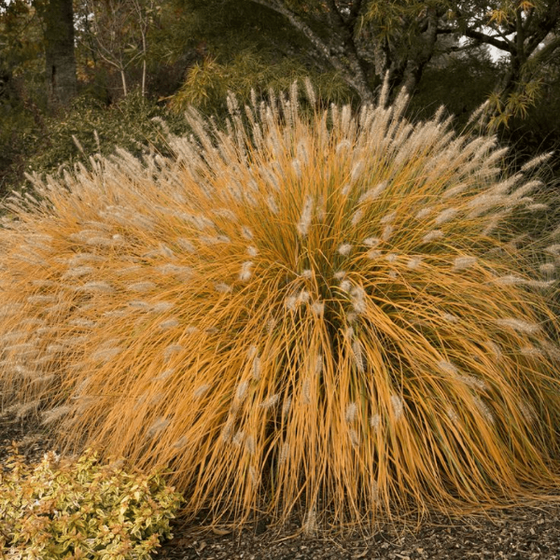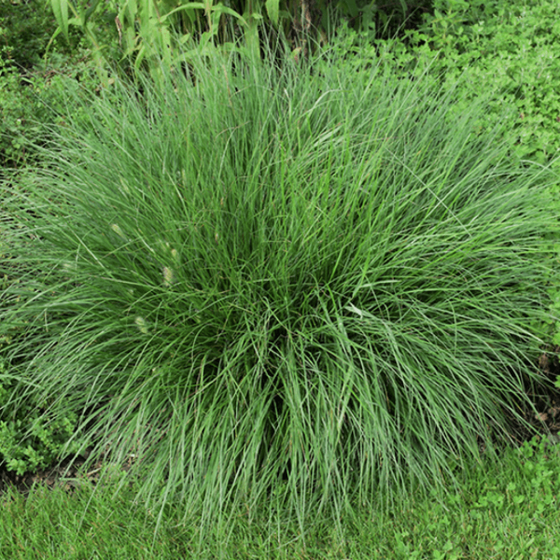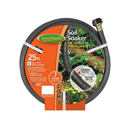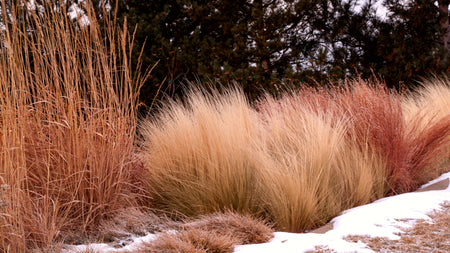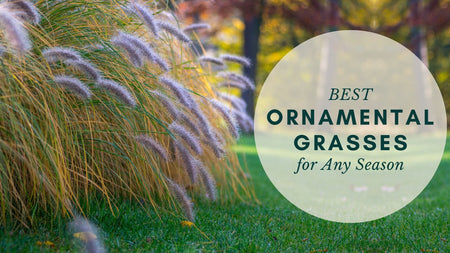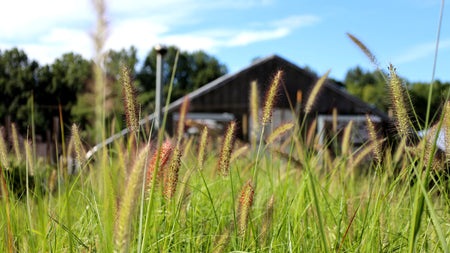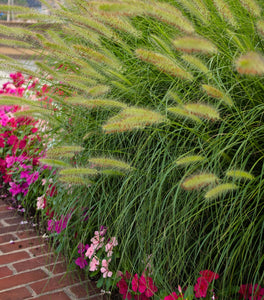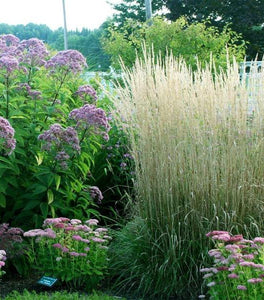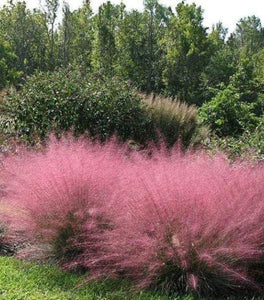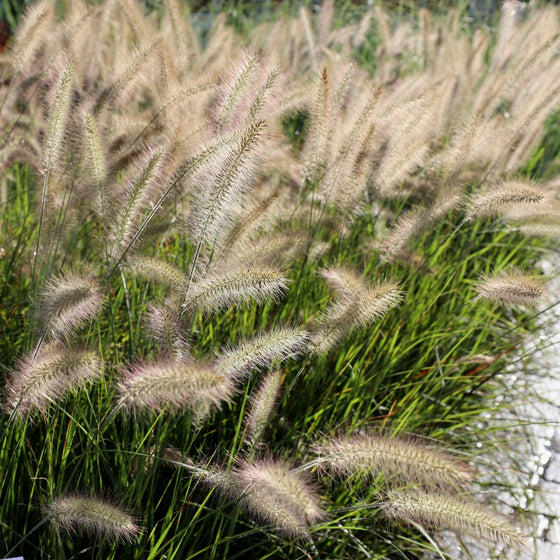
Images Depict Mature Plants
Fountain Grass for Sale Online
Fountain Grass (Pennisetum 'Hameln') is a graceful ornamental grass known for its arching foliage and feathery, bottlebrush-like flower plumes that bloom from late summer to fall. The rich green leaves form elegant mounds that sway gently in the breeze, adding movement and texture to the garden. The foliage often turns golden in the fall, offering additional seasonal interest. The soft, pinkish-tan flower plumes add a delicate touch, making Fountain Grass an ideal focal point or border plant in a variety of landscape designs. This versatile grass thrives in sunny garden beds, borders, or containers, perfect for adding height and structure.
Hardy in USDA Zones 5-9, Fountain Grass reaches a mature height of 2-3 feet with a spread of about 2-3 feet, making it suitable for both small and large gardens. This ornamental grass prefers full sun and well-drained soil but is adaptable to a variety of soil types. Once established, Fountain Grass is drought-tolerant and low-maintenance, making it an excellent choice for water-wise gardens. Its clumping growth habit helps prevent soil erosion, making it ideal for sloped areas or along pathways. The airy plumes also provide a striking contrast to flowering perennials and shrubs, adding depth and interest to the landscape.
In addition to its aesthetic appeal, this Fountain Grass is also deer-resistant, making it an excellent option for gardens where deer browsing is a concern. It pairs beautifully with other ornamental grasses, flowering perennials, and shrubs, creating a dynamic and visually appealing landscape. This grass is also great for attracting birds, as the seed heads provide food for wildlife in the fall and winter. Whether used as a specimen plant, in mass plantings, or as a container accent, Fountain Grass adds year-round beauty and texture to any garden.
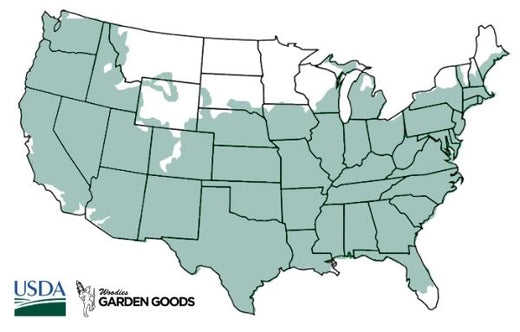
| Hardiness Zone: | 5-9 |
|---|---|
| Mature Height: | 2 to 3 Feet |
| Mature Width: | 2 to 3 Feet |
| Classification: | Warm season ornamental grass |
| Sunlight: | Full sun to part shade |
| Habit: | Clump forming |
| Foliage: | Rich red in spring, turning greenish red in summer |
| Flower Color: | Pinkish white beginning in August |
| Pruning Season: | Cut down to 6 inches in the late winter / early spring |
| Soil Condition: | Prefers average soil, but will tolerate wet soil |
| Water Requirements: | Water well until established |
| Uses: | Drought tolerant, ground cover, rain gardens, will grow under black walnuts, can be used to stabilize soil on slopes |
How to Care for Fountain Grass
Before you buy a Fountain Grass plant, make sure to read about the care instructions that are required and recommended to keep this plant healthy and thriving.
How do I Plant Fountain Grass?
To plant Fountain Grass (Pennisetum alopecuroides), start by selecting a location that receives full sun, as this ornamental grass thrives best in sunny spots. Ensure the soil is well-drained, as Fountain Grass prefers moist but not waterlogged conditions. Begin by digging a hole twice the width of the root ball and slightly deeper than the container. Place the grass in the hole, ensuring that the top of the root ball is level with the surrounding soil. Backfill the hole with soil, pressing it gently around the base to eliminate air pockets, and then water thoroughly to help the plant settle in. Adding a layer of mulch around the plant helps retain moisture and keep the soil cool. When planting Fountain Grass in groupings or as a mass planting, space the plants about 2-3 feet apart to allow for their mature spread. If planting in containers, use a pot with drainage holes and high-quality potting soil to ensure proper drainage. After planting, water the grass regularly during the first growing season to help establish strong roots. Once established, Fountain Grass is drought-tolerant and requires minimal care, making it ideal for low-maintenance gardens. With its graceful, arching foliage and feathery plumes, Fountain Grass adds height, texture, and year-round interest to borders, pathways, and containers.
How do I Water Fountain Grass?
To water Fountain Grass (Pennisetum alopecuroides 'Hameln') effectively, it’s important to provide consistent moisture during its first growing season to help establish a strong root system. After planting, water deeply and regularly, ensuring the soil remains moist but not soggy. Deep watering once or twice a week is usually sufficient, depending on your climate and rainfall. Be sure to let the top layer of soil dry out slightly between waterings, as Fountain Grass prefers well-drained soil. If planted in containers, check the soil more frequently, as pots tend to dry out faster than garden beds. Once Fountain Grass is established, it becomes drought-tolerant and requires less frequent watering. In most cases, natural rainfall is sufficient to keep the grass healthy, though supplemental watering may be needed during extended dry periods, especially in hot climates. When watering, aim to water deeply rather than frequently, allowing the soil to dry out between sessions. This promotes deeper root growth and helps the plant maintain its beautiful arching foliage and airy plumes. Regular, well-timed watering will ensure your Fountain Grass thrives, adding texture and movement to your garden throughout the season.
How do I Fertilize Fountain Grass?
Plants such as Pennisetum Hameln grow best if they are fertilized once in the spring and again in early summer. Pennisetum Hameln favors nutrient rich soil and ample fertilization. When selecting a fertilizer for your Pennisetum Hameln , if soil Ph is not an issue a simple balanced fertilizer can be used such as Espoma Flower-tone. We don’t recommend fertilizing Pennisetum Hameln after August in the North. Fall is the time for Pennisetums to begin preparing for dormancy. For a totally organic approach, many gardeners use commercial manure on the soil around plants such as Pennisetum Hameln. As with chemical fertilizers, do not apply it right next to the trunk or stems emerging from the ground.

How do I Prune Fountain Grass?
Pruning Fountain Grass (Pennisetum alopecuroides) is essential for maintaining its neat appearance and encouraging healthy new growth. The best time to prune is in late winter or early spring before new growth begins. Using sharp garden shears, cut back the foliage to about 3-6 inches above the ground. This clears away any dead or damaged blades from the previous season, allowing fresh, vibrant growth to emerge. Removing the old foliage also helps prevent pests and diseases from harboring in the dense clumps, ensuring the grass stays healthy and attractive throughout the growing season. During the growing season, Fountain Grass typically requires minimal pruning, as its graceful, arching foliage maintains a naturally tidy form. However, you can trim any damaged or overgrown blades if needed to keep the plant looking fresh. Avoid cutting the grass in mid-summer, as this can disrupt its natural blooming cycle. By pruning at the right time and keeping maintenance light, Fountain Grass will reward you with beautiful, flowing foliage and feathery plumes that enhance the texture and movement of your landscape all season long.

